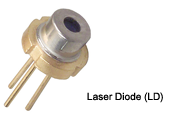
New display concepts are a dime a dozen. However, very few of them find their way beyond prototype stage, and even if they do, they usually can’t compete with the manufacturing muscle of the $100 billion liquid crystal display (LCD) industry. But a display startup called Prysm believes that its technology, called laser phosphor display (LPD), has the perfect combination of picture quality, energy efficiency, and manufacturing simplicity to have a chance of breaking through.
The San Jose-based Prysm, which came out of stealth mode last week, has been getting plenty of media attention due to its claims of energy efficiency. According to Roger Hajjar, the company’s chief technology officer, an LPD consumes a fourth of the power of a liquid crystal display with the same brightness and about a tenth of the power of a plasma screen (although an LPD also shines brighter than a plasma screen, so the comparison isn’t direct, according to Hajjar).
The concept behind LPD is relatively straightforward. Beams of light from several ultra-violet lasers are directed by a set of movable mirrors onto a screen made of a plastic-glass hybrid material coated with color phosphor stripes. The laser draws an image onto the screen by scanning line by line from top to bottom. The energy from the laser light activates the phosphor, which emits photons, producing an image.
Looks promising… bright image, low power, long-lasting, large format.
















I don’t think so.
That is almost exactly how the old CRTs work, except they didn’t have moving parts to break. They controlled the beam path with magnetic energy.
The mirror idea, that is like DLP, which has yet to find a large audience. The lifespan of the DLP TV’s sold in the last 10 years is around 4, before they start failing. Just Google “DLP problems” and you will see how bad it is. I can’t imagine that this would be any more reliable.
And lastly, the problem with phosphor pixels is that they don’t turn off fast enough. So high action apps, such as sports and games, have a hard time keeping the image fresh.
Interesting but it seems to still be a projection style technology – ie. micromirrors ala DLP.
I could not find info on thickness of TV’s – which is another vector consumers value. I’m not sure if this will blunt the momentum behind OLED displays.
If I can get a high-quality HDTV, I don’t care if it’s an inch thick or a foot thick.
#3 Yep. That’s what my father says too!
Most people these days want their TV’s off the floor.
Wouldn’t you want that also and make more room for your rocking chair?
So, as #1 says, its just a low reliability CRT.
There was an australian company about 2 years ago that demonstrated a laser TV (and not one that used moving mirrors and silly phosphors) that got everyone excited, but nobody has heard anything from them since. My guess is that they were bought by an international optometrist group for eye-surgery purposes.
As to reliability, I can’t tell from the article just how the mirrors are set up. It occurs to me that the laser/mirror arrangements in checkout scanners seem to have rather high reliability.
I would think phosphors aren’t a huge problem, because plasmas use them and run at 600Hz
Moving parts vs.none; phosphor wear vs. none; converge requirement versus none; hmmm, I still like my LCD and will some day like a comparably priced OLED. Energy savings not significant enough to make everything else equal.
How long does it to create a burnt in image?
Sounds good in theory but can they make a better screen at a lower price?
“movable mirrors”
Moving parts in a modern display = quantum fail.
Now if they directed the laserbeams in a solid-state way, say via magnetic fields…
Solid state near-UV lasers are cheap and plentiful thanks to Blu-ray players. A phase locked spinning prism, can paint a wall at 120Hz refresh rate with a motor out of a DVD burner. Phosphor coated class can be made in sheets 10′ wide. This is all off the shelf technology.
I lurk here all the time but I rarely post. This shit is just too juicy though. I was going to comment on how this is a terrible idea because it’s just basically some moron going hey, we can replace a cathode ray with a laser ray and it still works, but you astute readers caught it immediately. Bravo.
But I do have something else to say. And I mean this in a non-snarky, I-am-fucking-serious kinda way:
who gives a SHIT about energy efficiency?
Even a plasma uses a negligible amount of electricity, and where I live the juice of Tesla costs 4 cents a KWhr and thus all the environmentally-hip money-wasters can go lick my nuts.
Another fiasco that will never make it.
why is it that the shit always prevail.
DLP,LCD,PLASMA. The worst class of mobile image reproduction on earth.